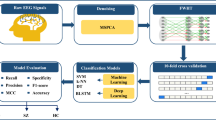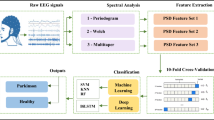Abstract
Migraine is a neurological disease defined by recurrent attacks of headache accompanied by nausea and vomiting, which causes autonomic nervous system disturbance, episodes of severe pain, are prolonged, and can have a major impact on quality of life. In this study, a deep learning model was proposed to assist expert judgment in the automatic detection of migraine using electroencephalography (EEG) signals. The dataset consists of EEG signals recorded from 21 healthy and 18 migraine volunteers. Feature vectors were created by calculating the power densities values of the frequencies between 1 and 49 Hz of the EEG signals using the Welch method. The performances of bidirectional long-short term memory (BiLSTM) deep learning algorithm and random forest, support vector machine, and linear discriminant analysis machine learning algorithms in EEG-based migraine classification tasks were compared using the created feature vectors. The algorithm with the highest performance is the BiLSTM (95.99%) deep learning algorithm using 128 channels. The study is a rare attempt in which a deep learning model is used in the effective diagnosis of automatic migraine by analyzing multi-channel EEG signals and provides evidence for the superiority of deep learning algorithms. In comparison to state-of-the-art investigations, more accuracy was achieved. With this model, the accuracy was increased by 6.3%.


Similar content being viewed by others
Data availability
The EEG signals used in this study are publicly available datasets. The dataset was downloaded from: “https://kilthub.cmu.edu/articles/dataset/Ultra_high-density_EEG_recording_of_interictal_migraine_and_ controls_sensory_and_rest/12636731" [14].
References
Jindal, K., Upadhyay, R., Singh, H.S., Vijay, M., Sharma, A., Gupta, K., Gupta, J., Dube, A.: Migraine disease diagnosis from EEG signals using non-linear feature extraction technique. In: 2018 IEEE International Conference on Computational Intelligence and Computing Research (ICCIC) (pp. 1–4). IEEE (2018)
Masson, R., Lévêque, Y., Demarquay, G., ElShafei, H., Fornoni, L., Lecaignard, F., Morlet, D., Bidet-Caulet, A., Caclin, A.: Auditory attention alterations in migraine: a behavioral and MEG/EEG study. Clin. Neurophysiol. (2020). https://doi.org/10.1016/j.clinph.2020.05.024
Stovner, L.J., Hagen, K., Jensen, R., Katsarava, Z., Lipton, R.B., Scher, A.I., Steiner, T.J., Zwart, J.A.: The global burden of headache: a documentation of headache prevalence and disability worldwide. Cephalalgia (2007). https://doi.org/10.1111/j.1468-2982.2007.01288.x
Vetvik, K.G., MacGregor, E.A.: Sex differences in the epidemiology, clinical features, and pathophysiology of migraine. Lancet Neurol. (2017). https://doi.org/10.1016/S1474-4422(16)30293-9
Ashina, M., Katsarava, Z., Do, T.P., Buse, D.C., Pozo-Rosich, P., Özge, A., Krymchantowski, A.V., Lebedeva, E.R., Ravishankar, K., Yu, S., Sacco, S., Ashina, S., Younis, S., Steiner, T.J., Lipton, R.B.: Migraine: epidemiology and systems of care. The Lancet (2021). https://doi.org/10.1016/S0140-6736(20)32160-7
Aslan, Z.: Migraine detection from EEG signals using tunable Q-factor wavelet transform and ensemble learning techniques. Phys. Eng. Sci. Med. (2021). https://doi.org/10.1007/s13246-021-01055-6
Gomez-Pilar, J., García-Azorín, D., Gomez-Lopez-de-San-Roman, C., Guerrero, Á.L., Hornero, R.: Exploring EEG spectral patterns in episodic and chronic migraine during the interictal state: determining frequencies of interest in the resting state. Pain Med. (2020). https://doi.org/10.1093/pm/pnaa117
De Tommaso, M.: An update on EEG in migraine. Expert Rev. Neurother. (2019). https://doi.org/10.1080/14737175.2019.1586534
Frid, A., Shor, M., Shifrin, A., Yarnitsky, D., Granovsky, Y.: A biomarker for discriminating between migraine with and without aura: machine learning on functional connectivity on resting-state EEGs. Ann. Biomed. Eng. (2020). https://doi.org/10.1007/s10439-019-02357-3
Subasi, A., Ahmed, A., Aličković, E., Hassan, A.R.: Effect of photic stimulation for migraine detection using random forest and discrete wavelet transform. Biomed. Signal Process. Control (2019). https://doi.org/10.1016/j.bspc.2018.12.011
Bellotti, R., De Carlo, F., De Tommaso, M., Lucente, M.: Migraine detection through spontaneous EEG analysis. In: 2007 29th Annual International Conference of the IEEE Engineering in Medicine and Biology Society (pp. 1834–1837). IEEE (2007)
Akben, S.B., Tuncel, D., Alkan, A.: Classification of multi-channel EEG signals for migraine detection. Biomed. Res. 27(3), 743–748 (2016)
Akhter, M.P., Jiangbin, Z., Naqvi, I.R., Abdelmajeed, M., Fayyaz, M.: Exploring deep learning approaches for Urdu text classification in product manufacturing. Enterp. Inf. Syst. (2022). https://doi.org/10.1080/17517575.2020.1755455
Chamanzar, A., Behrmann, M., Grover, P.: Ultra high-density EEG recording of interictal migraine and controls: sensory and rest. Carnegie Mellon University. (2020). https://doi.org/10.1184/R1/12636731. Dataset: https://kilthub.cmu.edu/articles/dataset/Ultra_high-density_EEG_recording_of_interictal_migraine_and_controls_sensory_and_rest/12636731. Accessed 10 Jan 2022
Chamanzar, A., Haigh, S.M., Grover, P., Behrmann, M.: Abnormalities in cortical pattern of coherence in migraine detected using ultra high-density EEG. Brain Commun. (2021). https://doi.org/10.1093/braincomms/fcab061
Agarwal, M., Sivakumar, R.: Cerebro: A wearable solution to detect and track user preferences using brainwaves. In: The 5th ACM Workshop on Wearable Systems and Applications (2019). https://doi.org/10.1145/3325424.3329660
Cao, Z., Lin, C.T., Lai, K.L., Ko, L.W., King, J.T., Liao, K.K., Fuh, J.L., Wang, S.J.: Extraction of SSVEPs-based inherent fuzzy entropy using a wearable headband EEG in migraine patients. IEEE Trans. Fuzzy Syst. (2020). https://doi.org/10.1109/TFUZZ.2019.2905823
Dursun, İ, Akın, M.: The use of synchrosqueezing method applied to EEG data in the diagnosis of migraine. Dicle Univ. J. Eng. 6, 66 (2021). https://doi.org/10.24012/dumf.1051421
Francis, M.N., Keran, M.P., Chetan, R., Krupa, B.N.: EEG-controlled robot navigation using Hjorth parameters and welch-psd. Int. J. Intell. Eng. Syst. (2021). https://doi.org/10.22266/ijies2021.0831.21
Basar, M.D., Duru, A.D., Akan, A.: Emotional state detection based on common spatial patterns of EEG. Signal Image Video Process. (2019). https://doi.org/10.1007/s11760-019-01580-8
Welch, P.: The use of fast Fourier transform for the estimation of power spectra: a method based on time averaging over short, modified periodograms. IEEE Trans. Audio Electroacoust. (1967). https://doi.org/10.1109/TAU.1967.1161901
Kourou, K., Exarchos, T.P., Exarchos, K.P., Karamouzis, M.V., Fotiadis, D.I.: Machine learning applications in cancer prognosis and prediction. Comput. Struct. Biotechnol. J. (2015). https://doi.org/10.1016/j.csbj.2014.11.005
Settouti, N., Bechar, M.E.A., Chikh, M.A.: Statistical comparisons of the top 10 algorithms in data mining for classification task. Int. J. Interact. Multimed. Artif. Intell. 4(1), 46–51 (2016)
Hochreiter, S., Schmidhuber, J.: Long short-term memory. Neural Comput. (1997). https://doi.org/10.1162/neco.1997.9.8.1735
Li, W., Sengupta, N., Dechent, P., Howey, D., Annaswamy, A., Sauer, D.U.: Online capacity estimation of lithium-ion batteries with deep long short-term memory networks. J. Power Sources (2021). https://doi.org/10.1016/j.jpowsour.2020.228863
Peng, T., Zhang, C., Zhou, J., Nazir, M.S.: An integrated framework of bi-directional long-short term memory (BiLSTM) based on sine cosine algorithm for hourly solar radiation forecasting. Energy (2021). https://doi.org/10.1016/j.energy.2021.119887
Başaran, E.: Classification of white blood cells with SVM by selecting SqueezeNet and LIME properties by mRMR method. Signal Image Video Process. (2022). https://doi.org/10.1007/s11760-022-02141-2
Zeng, G.: On the confusion matrix in credit scoring and its analytical properties. Commun. Stat. Theory Methods (2020). https://doi.org/10.1080/03610926.2019.1568485
Göker, H., Bülbül, H.I., Irmak, E.: The estimation of students' academic success by data mining methods. In: 2013 12th International Conference on Machine Learning and Applications, vol. 2, pp. 535–539. IEEE (2013)
Tosun, M., Çetin, O.: A new phase-based feature extraction method for four-class motor imagery classification. Signal Image Video Process. (2022). https://doi.org/10.1007/s11760-021-02035-9
Mohapatra, A., Thota, N., Prakasam, P.: Fake news detection and classification using hybrid BiLSTM and self-attention model. Multimed. Tools Appl. (2022). https://doi.org/10.1007/s11042-022-12764-9
Funding
No funding was received for conducting this study.
Author information
Authors and Affiliations
Contributions
HG: designing concepts of the study, application of data analysis and interpretation, implementation of methods and writing the manuscript.
Corresponding author
Ethics declarations
Competing interests
We declare no conflict of interest.
Ethical approval
This article does not contain any studies with human subjects or animals performed by any of the authors.
Additional information
Publisher's Note
Springer Nature remains neutral with regard to jurisdictional claims in published maps and institutional affiliations.
Rights and permissions
Springer Nature or its licensor holds exclusive rights to this article under a publishing agreement with the author(s) or other rightsholder(s); author self-archiving of the accepted manuscript version of this article is solely governed by the terms of such publishing agreement and applicable law.
About this article
Cite this article
Göker, H. Automatic detection of migraine disease from EEG signals using bidirectional long-short term memory deep learning model. SIViP 17, 1255–1263 (2023). https://doi.org/10.1007/s11760-022-02333-w
Received:
Revised:
Accepted:
Published:
Issue Date:
DOI: https://doi.org/10.1007/s11760-022-02333-w




